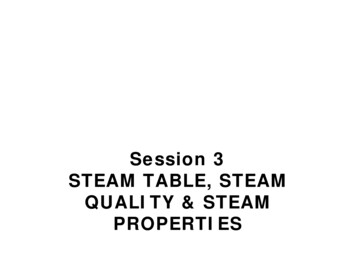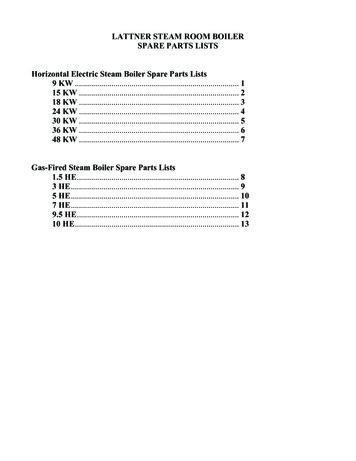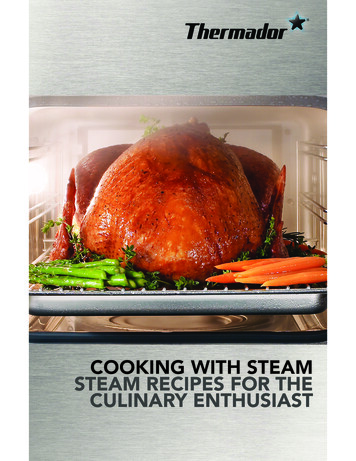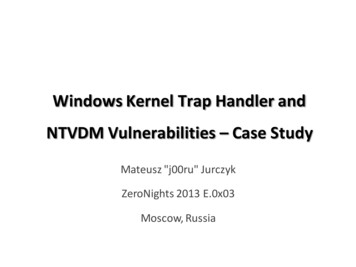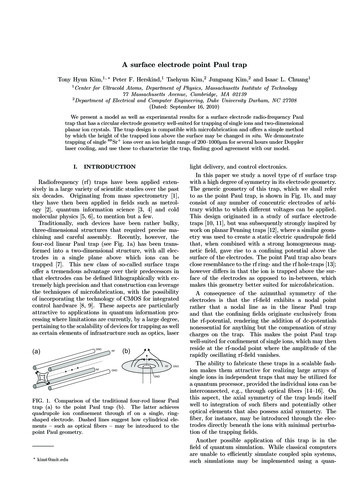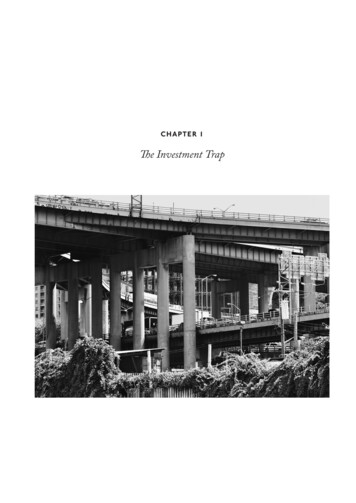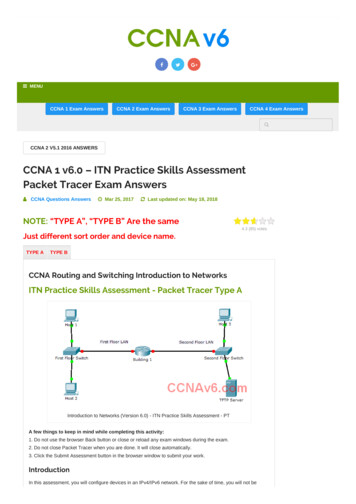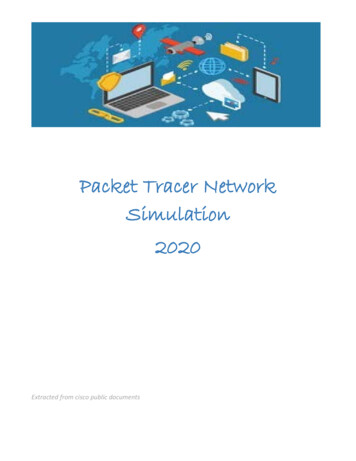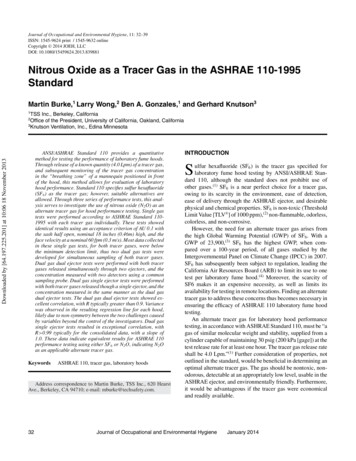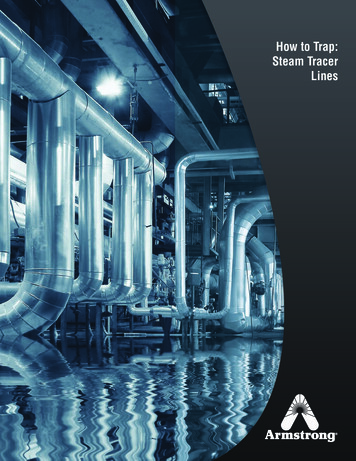
Transcription
How to Trap:Steam TracerLines1Designs, materials, weights and performance ratings are approximate and subject to change without notice. Visit armstronginternational.com for up-to-date information.North America Latin America India Europe / Middle East / Africa China Pacific Rimarmstronginternational.com
Bringing Energy Down to EarthSay energy. Think environment. And vice versa.Any company that is energy conscious is also environmentallyconscious. Less energy consumed means less waste, feweremissions and a healthier environment.In short, bringing energy and environment together lowersthe cost industry must pay for both. By helping companiesmanage energy, Armstrong products and services are alsohelping to protect the environment.Armstrong has been sharing know-how since we inventedthe energy-efficient inverted bucket steam trap in 1911. In theyears since, customers’ savings have proven again and againthat knowledge not shared is energy wasted.Armstrong’s developments and improvements in steam trapdesign and function have led to countless savings in energy,time and money. This section has grown out of our decadesof sharing and expanding what we’ve learned. It deals with theoperating principles of steam traps and outlines their specificapplications to a wide variety of products and industries.You’ll find it a useful complement to other Armstrong literatureand the Armstrong Steam-A-ware software program forsizing and selecting steam traps, pressure reducingvalves and water heaters, which can be requested throughArmstrong’s Web site, armstronginternational.com.This section also includes Recommendation Charts thatsummarize our findings on which type of trap will giveoptimum performance in a given situation and why.IMPORTANT: This section is intended to summarizegeneral principles of installation and operation of steamtraps, as outlined above. Actual installation and operationof steam trapping equipment should be performedonly by experienced personnel. Selection or installationshould always be accompanied by competent technicalassistance or advice. This data should never be usedas a substitute for such technical advice or assistance.We encourage you to contact Armstrong or its localrepresentative for further details.2Designs, materials, weights and performance ratings are approximate and subject to change without notice. Visit armstronginternational.com for up-to-date information.North America Latin America India Europe / Middle East / Africa China Pacific Rimarmstronginternational.com
Instructions for Using the Recommendation ChartsA quick reference Recommendation Chart appears throughoutthe “HOW TO TRAP” brochures (857-EN - 868-EN).A feature code system (ranging from A to Q) supplies youwith “at-a-glance” information.The chart covers the type of steam traps and the majoradvantages that Armstrong feels are superior for eachparticular application.3. Now refer to Chart 3-2 below, titled “How Various Typesof Steam Traps Meet Specific Operating Requirements”and read down the extreme left-handcolumn to each of the letters B, C, E, K, N. The letter“B,” for example, refers to the trap’s ability to provideenergy-conserving operation.4. Follow the line for “B” to the right until you reach thecolumn that corresponds to our first choice, in this casethe inverted bucket. Based on tests and actual operatingconditions, the energy-conserving performance of theinverted bucket steam trap has been rated “Excellent.”Follow this same procedure for the remaining letters.For example, assume you are looking for informationconcerning the proper trap to use on a gravity drainedjacketed kettle. You would:1. Turn to the “How to Trap Jacketed Kettles” brochure,864-EN, and look in the lower right-hand corner ofpage 10. The Recommendation Chart located there isreprinted below for your convenience. (Each section hasa Recommendation Chart.)AbbreviationsIBIBLVBMF&TCDDCInverted Bucket TrapInverted Bucket Large VentBimetallic TrapFloat and Thermostatic TrapControlled Disc TrapAutomatic DifferentialCondensate ControllerCV Check ValveTThermic BucketPRV Pressure Reducing Valve2. Find “Jacketed Kettles, Gravity Drain” in the firstcolumn under “Equipment Being Trapped” and readto the right for Armstrong’s “1st Choice and FeatureCode.” In this case, the first choice is an IBLV andthe feature code letters B, C, E, K, N are listed.Chart 3-1. Recommendation Chart(See chart below for “Feature Code” References.)1st Choice and FeatureCodeAlternate ChoiceJacketed KettlesGravity DrainIBLVB, C, E, K, NF&T or ThermostaticJacketed KettlesSyphon DrainDCB, C, E, G, H, K, N, PIBLVEquipment Being TrappedChart 3-2. How Various Types of Steam Traps Meet Specific Operating (4)(5)(1) Intermittent (2) od of OperationContinuousIntermittent(2) IntermittentContinuousContinuousBEnergy Conservation (Time in Service)ExcellentExcellentGoodPoorFair(3) ExcellentPoorCResistance to rrosion lentGoodEResistance to Hydraulic ShockExcellentExcellentPoorExcellent(4) PoorExcellentGoodFVents Air and CO2 at Steam TemperatureYesNoNoNoNoYesPoorGAbility to Vent Air at Very Low Pressure (1/4 psig)Poor(5) NRExcellent(5) NRGoodExcellentPoorHAbility to Handle Start-Up Air oorIOperation Against Back cellentPoorJResistance to Damage From Freezing(6) GoodGoodPoorGoodGoodGoodExcellentKAbility to Purge Performance on Very Light lentPoorMResponsiveness to Slugs of mmediatePoorNAbility to Handle tive Physical Size (7)LargeSmallLargeSmallSmallLargeSmallPAbility to Handle“Flash Steam”QMechanical Failure (Open or osed(8) Open(9)OpenNADrainage of condensate is continuous. Discharge is intermittent.Can be continuous on low load.Excellent when “secondary steam” is utilized.Bimetallic and wafer traps – good.Not recommended for low pressure operations.(6)(7)(8)(9)Cast iron traps not recommended.In welded stainless steel construction – medium.Can fail closed due to dirt.Can fail either open or closed, depending upon the design of the bellows.Designs, materials, weights and performance ratings are approximate and subject to change without notice. Visit armstronginternational.com for up-to-date information.North America Latin America India Europe / Middle East / Africa China Pacific Rimarmstronginternational.com3
Steam TablesWhat They Are How to Use ThemHow the Table Is UsedThe heat quantities and temperature/pressure relationships referred to inthis section are taken from the Propertiesof Saturated Steam table.In addition to determining pressure/temperature relationships, you cancompute the amount of steam that willbe condensed by any heating unit ofknown Btu output. Conversely, theSaturated Steam is pure steam at thetemperature that corresponds to theboiling temperature of water at theexisting pressure.Absolute and Gauge PressuresAbsolute pressure is pressure inpounds per square inch (psia) abovea perfect vacuum. Gauge pressure ispressure in pounds per square inchabove atmospheric pressure, which is14.7 pounds per square inch absolute.Gauge pressure (psig) plus 14.7 equalsabsolute pressure. Or, absolute pressureminus 14.7 equals gauge pressure.Table 4-1. Properties of Saturated Steam(Abstracted from Keenan and Keyes, THERMODYNAMIC PROPERTIES OF STEAM,by permission of John Wiley & Sons, Inc.)Col. 1GaugePressureInches of VacuumDefinitions of Terms UsedPressure/Temperature Relationship(Columns 1, 2 and 3). For everypressure of pure steam there is acorresponding temperature. Example:The temperature of 250 psig puresteam is always 406 F.Total Heat of Steam (Column 6). Thesum of the Heat of the Liquid (Column4) and Latent Heat (Column 5) in Btu.It is the total heat in steam above 32 F.Specific Volume of Liquid (Column 7).The volume per unit of mass in cubicfeet per pound.Specific Volume of Steam (Column 8).The volume per unit of mass in cubicfeet per pound.4PSIGHeat of Saturated Liquid (Column 4).This is the amount of heat requiredto raise the temperature of a poundof water from 32 F to the boilingpoint at the pressure and temperatureshown. It is expressed in Britishthermal units (Btu).Latent Heat or Heat of Vaporization(Column 5). The amount of heat(expressed in Btu) required to changea pound of boiling water to a pound ofsteam. This same amount of heat isreleased when a pound of steam iscondensed back into a pound of water.This heat quantity is different for everypressure/temperature combination, asshown in the steam table.table can be used to determine Btuoutput if steam condensing rate isknown. In the application portion ofthis section, there are several referencesto the use of the steam 3180.3200.3225.3250.3Col. 2AbsolutePressure(psia)Col. 3SteamTemp.( F)Col. 4Heatof Sat.Liquid(Btu/lb)Col. 5LatentHeat (Btu/lb)Col. 6TotalHeat ofSteam(Btu/lb)Col. 7SpecificVolume ofSat. Liquid(cu 0.023460.024280.025650.028600.030270.05053Col. 8SpecificVolumeof Sat.Steam .360.280.240.190.130.110.05Designs, materials, weights and performance ratings are approximate and subject to change without notice. Visit armstronginternational.com for up-to-date information.North America Latin America India Europe / Middle East / Africa China Pacific Rimarmstronginternational.com
Steam TablesFlash Steam (Secondary)What is flash steam? When hot condensate or boilerwater, under pressure, is released to a lower pressure, partof it is re-evaporated, becoming what is known as flash steam.Why is it important? This flash steam is important becauseit contains heat units that can be used for economical plantoperation—and which are otherwise wasted.How is it formed? When water is heated at atmosphericpressure, its temperature rises until it reaches 212 F,the highest temperature at which water can exist at thispressure. Additional heat does not raise the temperature,but converts the water to steam.The heat absorbed by the water in raising its temperatureto boiling point is called “sensible heat” or heat of saturatedliquid. The heat required to convert water at boiling pointto steam at the same temperature is called “latent heat.”The unit of heat in common use is the Btu, which is theamount of heat required to raise the temperature of onepound of water 1 F at atmospheric pressure.If water is heated under pressure, however, the boilingpoint is higher than 212 F, so the sensible heat requiredis greater. The higher the pressure, the higher the boilingtemperature and the higher the heat content. If pressureis reduced, a certain amount of sensible heat is released.This excess heat will be absorbed in the form of latent heat,causing part of the water to “flash” into steam.Chart 5-3.Percentage of flash steam formed when dischargingcondensate to reduced pressure.Condensate at steam temperature and under 100 psigpressure has a heat content of 308.8 Btu per pound. (SeeColumn 4 in Steam Table.) If this condensate is dischargedto atmospheric pressure (0 psig), its heat content instantlydrops to 180 Btu per pound. The surplus of 128.8 Bture-evaporates or flashes a portion of the condensate.The percentage that will flash to steam can be computedusing the formula:% flash steam SH - SL x 100HSH Sensible heat in the condensate at the higherpressure before discharge.SL Sensible heat in the condensate at the lowerpressure to which discharge takes place.H Latent heat in the steam at the lower pressureto which the condensate has been discharged.% flash steam 308.8 - 180 x 100 13.3%970.3C
Armstrong’s developments and improvements in steam trap design and function have led to countless savings in energy, time and money. This section has grown out of our decades of sharing and expanding what we’ve learned. It deals with the operating principles of steam traps and outlines their specific applications to a wide variety of products and industries. You’ll find it a useful .
